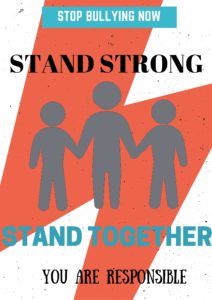Relational bullying is considered to be the intentional act to hurt someone by damaging their reputation and social relationships. It is also considered to be one of the most common forms of bullying. Bullying is commonly perceived to look a certain way such as kids being thrown up against the school lockers by bigger kids. This perception is one valid truth about bullying, however, there are many more ways people can stimulate bullying including: Cyberbullying: this is known to be bullying through social media. Gossip & Rumors: Spread throughout a population of individual about someone. It establishes social. Bullies typically target those who may be seen as a threat. Exclusion: This involves the act of ignoring or dismissing someone’s presence or need of belonging. The goal of the project is to help these individuals identify and distinguish relational bullying from physical bullying and implement strategies to both prevent and respond to relational bullying that occurs
A common thread that gender, socialization, and power all have is that boys are expected to carry this masculine personality. Both males and females are taught to conform to what their gender roles call them for, whether that is taking care of the family or providing for them. In relation to bullying, gender socialization for men carries the role of how they should be strong and have interests in more masculine ideals. Bullying comes into play when the actions or personality of a boy does not fall in close alignment to what is considered normal for a boy to like or do. Power then steps in when there is an imbalance in personality and role. This creates a division for the victim from the social world because then they start to believe that is really what others think about them. They begin to shut down which continues to enable the aggressor to bully.
Taunts and jokes using homophobic slang (“Fag discourse”) have as much to do with the definition of masculinity as it has to do with the fear of gay men. Homophobic language are central to shaping contemporary heterosexual masculine identities. The use of homophobic language is not just directed toward LGTBQ+ youth, but directed at straight men as well as a way of socializing acceptable hegemonic masculine activities and unacceptable behavior to learn how to “be a boy.” How one may approach identifying bullying includes understanding what exactly is bullying, such as verbal, physical and social abuse. Other factors may include how often the occurrence of this act is as well as an imbalance of power between the bully and the victim. We need to understand what bullying is and what bullying is not. Bullying is reoccurring, Represents a power imbalance between the victim and the aggressor, and is intended to cause harm.
Most literature on bullying is framed from a psychological standpoint, or individual influences and causes, rather than examining bullying as a part of the gendered socialization process. This is too simplistic a definition. We need to look at the sociology of bullying instead. In the most simplistic terms, kids are bullied for being different. Differences that often reflect broader social issues such as race, gender, and class. Bullying reflects on onset of power of the norm over the difference, also reflecting the prevalence of that social power in the larger social network.
In this presentation, we identify groups at risk of bullying based upon their gender, race, physical abilities, weight, sexual orientation, socioeconomic status, and religion. We also provide ways in which to identify those that are more likely to bully and those more likely to be bullied, while also cautioning that those roles are not static and identification of these individuals can sometimes be difficult. We include information about how bullying is currently assessed and who is currently most involved in handling bullying in schools. We provide opportunities and approaches for administrators, teachers, and coaches to address bullying based upon studies that identify the most effective ways to prevent and stop bullying
telling stories, hearing lives
© 2026 Cultures of Engagement
Theme by Anders Noren — Up ↑



Recent Comments